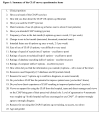Ambulance officers' use of online clinical evidence
- PMID: 16872507
- PMCID: PMC1544324
- DOI: 10.1186/1472-6947-6-31
Ambulance officers' use of online clinical evidence
Abstract
Background: Hospital-based clinicians have been shown to use and attain benefits from online evidence systems. To our knowledge there have been no studies investigating whether and how ambulance officers use online evidence systems if provided. We surveyed ambulance officers to examine their knowledge and use of the Clinical Information Access Program (CIAP), an online evidence system providing 24-hour access to information to support evidence-based practice.
Methods: A questionnaire was completed by 278 ambulance officers in New South Wales, Australia. Comparisons were made between those who used CIAP and officers who had heard of, but not used CIAP.
Results: Half the sample (48.6%) knew of, and 28.8% had used CIAP. Users were more likely to have heard of CIAP from a CIAP representative/presentation, non-users from written information. Compared to ambulance officers who had heard of but had not used CIAP, users were more likely to report better computer skills and that their supervisors regarded use of CIAP as a legitimate part of ambulance officers' clinical role. The main reasons for non-use were lack of access(49.0%) and training(31.4%). Of users, 51.3% rated their skills at finding information as good/very good, 67.5% found the information sought all/most of the time, 87.3% believed CIAP had the potential to improve patient care and 28.2% had directly experienced this. Most access to CIAP occurred at home. The databases frequently accessed were MIMS (A medicines information database) (73.8%) and MEDLINE(67.5%). The major journals accessed were Journal of Emergency Nursing(37.5%), American Journal of Medicine(30.0%) and JAMA(27.5%).
Conclusion: Over half of ambulance officers had not heard of CIAP. The proportion who knew about and used CIAP was also low. Reasons for this appear to be a work culture not convinced of CIAP's relevance to pre-hospital patient care and lack of access to CIAP at work. Ambulance officers who used CIAP accessed it primarily from home and valued it highly. Lack of access to CIAP at central work locations deprives ambulance officers of many of the benefits of an online evidence system.
Figures

Similar articles
-
Use of point-of-care online clinical evidence by junior and senior doctors in New South Wales public hospitals.Intern Med J. 2005 Jul;35(7):399-404. doi: 10.1111/j.1445-5994.2005.00836.x. Intern Med J. 2005. PMID: 15958109
-
Nurses' use of online clinical evidence.J Adv Nurs. 2004 Jul;47(2):201-11. doi: 10.1111/j.1365-2648.2004.03079.x. J Adv Nurs. 2004. PMID: 15196194
-
Do clinicians use online evidence to support patient care? A study of 55,000 clinicians.J Am Med Inform Assoc. 2004 Mar-Apr;11(2):113-20. doi: 10.1197/jamia.M1385. Epub 2003 Dec 7. J Am Med Inform Assoc. 2004. PMID: 14662801 Free PMC article.
-
Measuring the Impact of Online Evidence Retrieval Systems using Critical Incidents & Journey Mapping.Stud Health Technol Inform. 2005;116:533-8. Stud Health Technol Inform. 2005. PMID: 16160312 Review.
-
Literature-searching strategies to improve the application of evidence-based clinical practice principles to stroke care.Mayo Clin Proc. 2004 Oct;79(10):1321-9. doi: 10.4065/79.10.1321. Mayo Clin Proc. 2004. PMID: 15473418 Review.
References
-
- Ayres D, Wensley M. The clinical information access project. Med J Aus. 1999;171:544–546. - PubMed
-
- Westbrook J, Coiera E, Gosling AS, Braithwaite J. Critical incidents and journey mapping as techniques to evaluate the impact of online evidence retrieval systems on health care delivery and patient outcomes. Int J Med Inform. 2006. - PubMed
Publication types
MeSH terms
LinkOut - more resources
Full Text Sources

